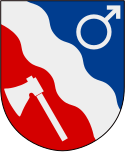Borlänge
| |||
 Borlänge | |||
| |||
| Państwo | |||
| Region | |||
| Gmina | Borlänge | ||
| Powierzchnia | 31,65[1] km² | ||
| Populacja (2018) • liczba ludności • gęstość | 43 107[1] 1362[1] os./km² | ||
| Strona internetowa | |||
| Portal | |||
Borlänge – miasto w środkowej Szwecji, w regionie Dalarna nad rzeką Dalälven, w przemysłowym regionie Bergslagen. Główny ośrodek gminy Borlänge. Około 41 700 mieszkańców[2].
Z miasta tego pochodzą: Thobias Fredriksson, dwukrotny medalista igrzysk olimpijskich i mistrzostw świata, członkowie zespołu Mando Diao, hokeista Mattias Ekholm.
W mieście znajduje się stacja kolejowa Borlänge centralstation.
W mieście rozwinął się przemysł papierniczy, spożywczy oraz hutniczy[3].
Przypisy
- ↑ a b c Statistiska tätorter 2018; befolkning, landareal, befolkningstäthet (szw.). Statistikmyndigheten SCB, 2020-03-20. [dostęp 2020-09-08]. [zarchiwizowane z tego adresu (2020-03-24)].
- ↑ Szwedzki Urząd Statystyczny SCB (szw.)
- ↑ Borlänge, [w:] Encyklopedia PWN [online] [dostęp 2021-06-06].
Media użyte na tej stronie
(c) Lokal_Profil, CC BY-SA 2.5
This coat of arms was drawn based on its blazon which – being a written description – is free from copyright. Any illustration conforming with the blazon of the arms is considered to be heraldically correct. Thus several different artistic interpretations of the same coat of arms can exist. The design officially used by the armiger is likely protected by copyright, in which case it cannot be used here.
Individual representations of a coat of arms, drawn from a blazon, may have a copyright belonging to the artist, but are not necessarily derivative works.
Autor: User Per Johansson on sv.wikipedia, Licencja: CC-BY-SA-3.0
Foto av Sveatorget i Borlänge, taget av Per Johansson 2005.
Autor: Erik Frohne, Licencja: CC BY 3.0
Location map of Dalarna County in Sweden
Equirectangular projection, N/S stretching 206 %. Geographic limits of the map:
- N: 62.30° N
- S: 59.70° N
- W: 12.00° E
- E: 16.90° E
(c) Lokal_Profil, CC BY-SA 2.5
This coat of arms was drawn based on its blazon which – being a written description – is free from copyright. Any illustration conforming with the blazon of the arms is considered to be heraldically correct. Thus several different artistic interpretations of the same coat of arms can exist. The design officially used by the armiger is likely protected by copyright, in which case it cannot be used here.
Individual representations of a coat of arms, drawn from a blazon, may have a copyright belonging to the artist, but are not necessarily derivative works.








